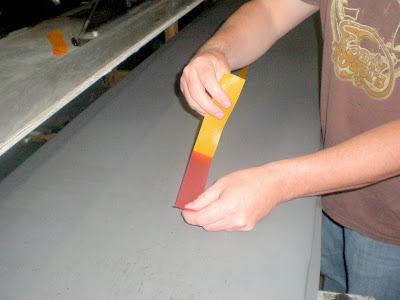I frequently receive emails from readers asking how fiberglass fly rod blanks are made and what equipment is required. The short answer is that it's not likely a project that you'd want to take on in your garage or basement.
A few weeks ago Mike McFarland of McFarland Rods emailed me a stack of photographs which explains step by step the process in rolling a fiberglass fly rod blank.
1. A roll of yellow E-Glass waiting to be turned into a sweet fly rod. The red part is just a backing and gets peeled off before rolling.
2. Patterns are precisely measured and ready to be cut.
3. Patterns are cut to size with sharp razor blade.
4. Backing material is peeled from pattern.
5. The pattern is tacked to the steel mandrel. Mandrels are ground to precise tolerances and are coated with a release agent prior to rolling.
6. The mandrel with tacked pattern is placed on the rolling table. The lower platen features an air filled bladder that perfectly conforms to taper of the part.
7. The top platen drop to sandwich the part under high pressure. Pressure is adjusted according to size of part being rolled.
8. The lower platen moves away from the operator and rolls the part on the mandrel.
9. Lower platen returns to its original position as the top platen raises to reveal the rolled blank.
10. A small piece of scrap glass is applied to the base of the blank. This gives the mandrel puller something to grab while extracting the mandrel.
11. The rolled blank is then moved to the tape machine. The carriage on the machine travels the length of the blank and spirals the cellophane equally the entire length of the blank. The carriage and chuck are geared together and speed can be increased or decreased without changing the overlap of the tape.
12. The blank then moves to the curing oven. I built the oven which is just under twelve feet tall. Blanks will cure for about two hours.
13. After curing, the mandrels are extracted with a pneumatic pulling machine. Different dies are used to fit each blank and they butt up against the pull tab that was added earlier.
14. Once the mandrels are pulled, the blank is ready to be ferruled and sanded/painted depending on the model.
Check out the McFarland Rods website for more information.
A few weeks ago Mike McFarland of McFarland Rods emailed me a stack of photographs which explains step by step the process in rolling a fiberglass fly rod blank.
1. A roll of yellow E-Glass waiting to be turned into a sweet fly rod. The red part is just a backing and gets peeled off before rolling.
2. Patterns are precisely measured and ready to be cut.
3. Patterns are cut to size with sharp razor blade.
4. Backing material is peeled from pattern.
5. The pattern is tacked to the steel mandrel. Mandrels are ground to precise tolerances and are coated with a release agent prior to rolling.
6. The mandrel with tacked pattern is placed on the rolling table. The lower platen features an air filled bladder that perfectly conforms to taper of the part.
7. The top platen drop to sandwich the part under high pressure. Pressure is adjusted according to size of part being rolled.
8. The lower platen moves away from the operator and rolls the part on the mandrel.
9. Lower platen returns to its original position as the top platen raises to reveal the rolled blank.
10. A small piece of scrap glass is applied to the base of the blank. This gives the mandrel puller something to grab while extracting the mandrel.
11. The rolled blank is then moved to the tape machine. The carriage on the machine travels the length of the blank and spirals the cellophane equally the entire length of the blank. The carriage and chuck are geared together and speed can be increased or decreased without changing the overlap of the tape.
12. The blank then moves to the curing oven. I built the oven which is just under twelve feet tall. Blanks will cure for about two hours.
13. After curing, the mandrels are extracted with a pneumatic pulling machine. Different dies are used to fit each blank and they butt up against the pull tab that was added earlier.
14. Once the mandrels are pulled, the blank is ready to be ferruled and sanded/painted depending on the model.
Check out the McFarland Rods website for more information.















2 comments:
Beautiful. I sure have a soft spot for the yellow and lemon glasses.
this is cool! and it looks so easy... why then do i have to wait so long for my rods? :)
Post a Comment